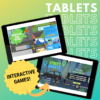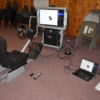Smash Match is available for schools to borrow. This is a timed shape-matching activity that helps you demonstrate a person’s susceptibility to the impairing effect of alcohol simulated through the impaired goggles. It can be used as a stand-alone activity to bring awareness to the danger of impaired driving or as part of a larger discussion on the subject.
Tablet Activities
The tablets contain multiple videos and one interactive game which students can complete on their own. Videos cover: passing large trucks and buses safely, stopping distances of large trucks and buses, and turning radius of trucks and buses. The interactive games have several sections and challenges. The student must answer questions correctly to get a full code to successfully complete the game.
What Would You Do? Risk Scenarios
This activity is a great way to bring awareness to 5 of the top risks for teen passengers and drivers. The scenarios will immerse students in real-life situations, which they may face as drivers or passengers, challenging them to understand the consequences of their decisions without any actual danger.
Driving Simulator Activity
The DWI Simulator is available for schools to borrow. Its primary focus is on impaired driving and can simulate what driving with a .17 BAC would look like. In addition to a focus on impaired driving, the simulator could also focus on the dangers of distractions (by having the driver text while driving or answer questions), nighttime driving, speeding, and focus on looking out for pedestrians and bicyclists.
Sleep Shocker!
The TDS team will conduct a poll on how many hours their peers slept the night before. The results of the poll will be displayed in the hallway to show how many “drowsy drivers” are walking the halls.
No Need for Speed Bulletin Board
Bulletin boards in high-traffic areas provide you with a great opportunity to reach your peers. Use the “No Need for Speed” bulletin board resources provided in your resource kit to create a bulletin board that provides valuable information and starts a conversation about the negative effect speed has on car crashes and how teens can speak up for their safety.




